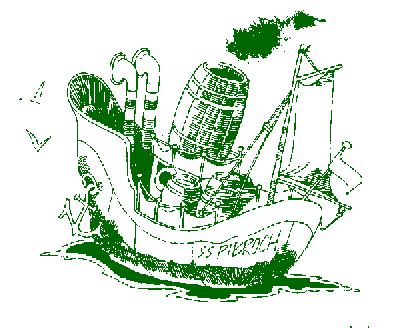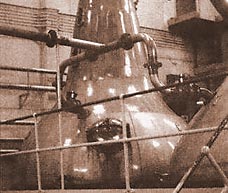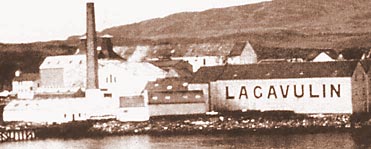There is a scattering of houses on the southern shore of Islay know as "Lagganmhoullin". The English translation from the Gaelic is "the mill in the hollow". This gives a strangely tranquil impression of this wild and very windswept, often bleak spot on the southern shore of Islay. A spot washed and battered by the prevailing south-westerlies which have had the full width of the Atlantic in which to gather their wrath before venting it upon the island. Alfred Barnard described the environs of Lagavulin distillery on his visit in 1885: "The works are built at the head of a miniature bay, around which rocks of fantastic shape rise abruptly from the sea; in some places detached masses have fallen in such a position that they rise from the sea like weird monsters of the deep".
 In 1156 a great sea battle was fought
off the west coast of Islay. Somerled, who became the first Lord
of the Isles, wrested control of the Inner Hebrides from Godred
of Man and Lagavulin Bay was the shelter he sought in victory.
Two generations later, Somerled's grandson, Donald I, built
Dunyvaig Castle to protect his fleet and the remains watch over
the distillery today. It was also from here that 1800 Ilich
(Islaymen), tacksmen of Angus Og, the then Lord of the Isles, set
sail in 1314 to support Bruce at Bannockburn.
In 1156 a great sea battle was fought
off the west coast of Islay. Somerled, who became the first Lord
of the Isles, wrested control of the Inner Hebrides from Godred
of Man and Lagavulin Bay was the shelter he sought in victory.
Two generations later, Somerled's grandson, Donald I, built
Dunyvaig Castle to protect his fleet and the remains watch over
the distillery today. It was also from here that 1800 Ilich
(Islaymen), tacksmen of Angus Og, the then Lord of the Isles, set
sail in 1314 to support Bruce at Bannockburn.
Due to the loyalty of the Campbells to the crown after the Act of Union, and the remoteness of the isles from Edinburgh, Islay and Jura were exempted from the control of the Board of Excise between 1707 and 1823. The lairds were given the right to collect Excise duties on the islands - and allowed to keep any monies gathered. The result was that taxes were levied on very few occasions.
Thus distilling blossomed on Islay and, in 1742, there were 10 bothies operating around Lagavulin Bay. By the end of the 18th century, these had merged to form today's distillery.
Islay's distilleries' very existence is inextricably linked with Poseidon's kingdom. The barley is carried in by sea and the make is taken out by sea; chust like Para Handy, Lagavulin had its own Clyde puffer, the S.S. Pibroch which plied between Glasgow and Islay from 1924 to 1956; the distilleries' white-washed walls, being situated on the shoreline, are regularly washed clean by the sea, as it forces its way through air-bricks and windows to form puddles of salt-water on the warehouses' earthen floors; the peat growing around Lagavulin has a high moss content and soaks up the flavours of the sea while the air is filled with its aromas and the cries of its birds.
 The use of peat is endemic
in the north-western highlands and islands of Scotland and
particularly so on Islay, where there is no other
naturally-occurring combustible material with which to dry the
malt. As, historically, the malt would have been dried using only
peat, Lagavulin's make of the last century was most probably even
more smokily pungent than it is today.
The use of peat is endemic
in the north-western highlands and islands of Scotland and
particularly so on Islay, where there is no other
naturally-occurring combustible material with which to dry the
malt. As, historically, the malt would have been dried using only
peat, Lagavulin's make of the last century was most probably even
more smokily pungent than it is today.
Lagavulin no longer operates its own floor maltings, instead making use of United Distillers' maltings at Port Ellen. There, the malt is produced to Lagavulin's own particular "recipe": a specific time dried by gas, followed by an exact time dried by the island's peat. The computer-controlled drum maltings give a high degree of precision and ensure that exactly the same degree of phenol absorption is achieved each time. This gives the distiller a more consistent malt. The island's water supplies are also impregnated by the peat making it the colour of the whiskies and causing tourists to comment that their bath water is dirty before they step into it. Lagavulin's water is no different, coming as it does from the nearby Lochan Sholum, which is situated at a height of 200 metres above sea level. This soft water flows two and a half miles, through the peat, down the hillside to the distillery.
The casks ageing at Lagavulin are expirating every second of the day and as the spirit softens and matures, it loses alcohol and volume. The vacuity within the cask, while full of spirit and whisky aromas also inhales aromas from the cask's surroundings. In the case of Lagavulin, the cask absorbs aromas of seaweed, fish, ozone and the bracing influence of Lagavulin's sea-air; the spirit in turn absorbs elements of these characteristics.
 The distillery's Production
Manager is Donnie MacKinnon, a former rugby player for the Islay
rugby team with a beard to help insulate him against the
south-westerlies. An Ileach born and bred, he has done most jobs
at Lagavulin in the past 34 years (as well as being a pantry boy
on the Caledonian-MacBrayne ferry which plies between the
mainland and Islay when he first left school) and has seen the
industry change and the size of its workforce fall. He talks with
regret about some of the "progress", but states proudly
that "the quality control is now much better now than it has
ever been."
The distillery's Production
Manager is Donnie MacKinnon, a former rugby player for the Islay
rugby team with a beard to help insulate him against the
south-westerlies. An Ileach born and bred, he has done most jobs
at Lagavulin in the past 34 years (as well as being a pantry boy
on the Caledonian-MacBrayne ferry which plies between the
mainland and Islay when he first left school) and has seen the
industry change and the size of its workforce fall. He talks with
regret about some of the "progress", but states proudly
that "the quality control is now much better now than it has
ever been."
Donnie's stills are very unusual in that they greatly resemble a totally spherical globe onion, from the bulbous base to the quite high apex and their narrow, steeply-sloping lye pipes. The spirit they produce has been likened to "a Gaelic hymn to the glorification of peat". Lagavulin is always among the biggest, most full-bodied of malts, the peat reek in the spirit's youth resembling burnt mahogany, with the burnt heather roots character coming through as it matures. The sea's influence is almost restrained, hidden by the peat, with just a touch of salt on the lips and a little prevalent sweetness which is further brought out if aged in a sherry cask.
John Lamond

Unless otherwise noted, all information in this site © The Scotch Malt Whisky Society, Edinburgh, Scotland, 1997.